When studying English, it is impossible to ignore such a topic as animals. Animals are mentioned in ordinary daily conversations, films are made about them and books are written, animals are often the heroes of common expressions and jokes.
IN English All animal names are neuter and can be replaced by the pronoun it.
The whale is in the sea- Whale in the sea.
It is in the sea- He's at sea.
But in the case when it is necessary to indicate the gender of an animal or indicate its special place, you can use the pronouns he or she.
This is my wombat. She is two years old- This is my wombat. She is two years old.
We have prepared for you a list of the most common wild and domestic animals and a table of how the animals themselves “speak” in English.
Pets
| Title in Russian | Title in English | Transcription |
|---|---|---|
| cat | cat | |
| dog | dog | |
| hamster | hamster | [ˈhamstər] |
| cow | cow | |
| goose | goose | |
| pig | pig | |
| sheep | sheep | |
| chicken | han | |
| rat | rat | |
| turtle | turtle | [ˈtərtl] |
| parrot | parrot | [ˈparət] |
| ferret | ferret | [ˈferət] |
| mouse | mouse | |
| bull | bull | |
| goat | goat | |
| turkey | turkey | [ˈtərkē] |
| goldfish | goldfish | [ˈgōldˌfiSH] |
| donkey | donkey | [ˈdɒŋki] |
| horse | horse | |
| rooster | rooster | [ˈro͞ostər] |

Forest animals
| Title in Russian | Title in English | Transcription |
|---|---|---|
| hare | rabbit | [ˈrabit] |
| wolf | wolf | |
| fox | fox | |
| snake | snake | |
| owl | owl | |
| bat | bat | |
| beaver | beaver | [ˈbēvər] |
| bear | bear | |
| mole | mole | |
| woodpecker | woodpecker | [ˈwo͝odˌpekər] |
| elk | moose | |
| squirrel | squirrel | [ˈskwər(ə)l] |
| lynx | lynx | |
| deer | deer | |
| lizard | lizard | [ˈlizərd] |
| boar | boar | |
| marten | marten | [ˈmärtn] |
| swan | swan | |
| hedgehog | hedgehog | [ˈhɛdʒ(h)ɒɡ] |
| pheasant | pheasant | [ˈfezənt] |
Wild animals
| Title in Russian | Title in English | Transcription |
|---|---|---|
| lion | lion | [ˈlīən] |
| tiger | tiger | [ˈtīgər] |
| giraffe | giraffe | |
| hippopotamus | hippo | [ˈhɪpəʊ] |
| wombat | wombat | [ˈwämˌbat] |
| ostrich | ostrich | [ˈästriCH] |
| whale | whale | [(h)wal] |
| elephant | elephant | [ˈeləfənt] |
| zebra | zebra | [ˈzēbrə] |
| crocodile | crocodile | [ˈkräkəˌdīl] |
| monkey | monkey | [ˈməNGkē] |
| dolphin | dolphin | [ˈdälfin] |
| eagle | eagle | [ˈēgəl] |
| kangaroo | kangaroo | |
| shark | shark | |
| rhinoceros | rhinoceros | |
| penguin | penguin | [ˈpeNGgwin] |
| walrus | walrus | [ˈwôlrəs] |
| koala | koala | |
| cheetah | cheetah | [ˈCHētə] |
| antelope | antelope | [ˈantlˌōp] |
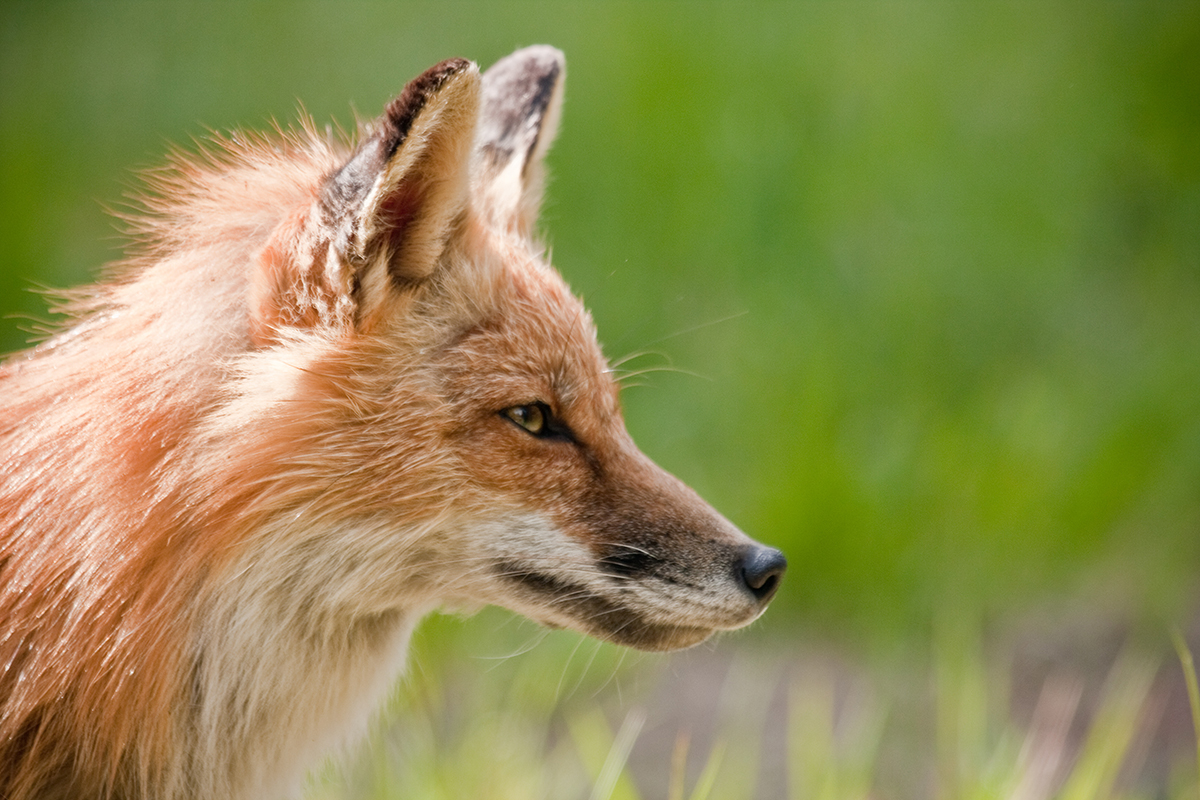
How animals say in English
| Animal | Sounds in Russian | Translation into English |
|---|---|---|
| cat (cat) | meow | meow |
| dog (dog) | woof | Woof! |
| rooster | ku-ka-re-ku | Cock-A-Doodle-Doo! |
| sheep (sheep) | b-e | ba-a-ba-a |
| goat (goat) | meh | baaaaaah |
| hen (chicken) | co-co-co | cluck-cluck |
| cow | mu | moo-moo |
| crow | kar-kar | caw, caw |
| mouse (mouse) | pee-pee-pee | squeak-squeak |
| donkey (donkey) | Eeyore | hee-haw |
| frog (frog) | qua-qua | quack-quack |
| pig (pig) | oink-oink | grunt-grunt |
| snake | shhh | ch-ch |
| horse (horse) | yoke | neigh-neigh |
| lion (lion) | rrrrrrrr | grrrrrrr |
| birds (birds) | tweet-chirp | tweet tweet tweet |
| owl (owl) | woohoo | hoo-hoo |
| bee | zhzhzhzh | bzzz |
| cuckoo (cuckoo) | peek-a-boo | Cuckoo! |
| purr (purr) | purr-murr | purr, purr |
Animal names for children
It is much easier for a child to learn the names of animals in English with the help of songs and poems, especially when they are accompanied by visuals. On the Internet you can find many cartoons and short videos about domestic and wild animals and the sounds they make. We have made a small selection of such videos for you.
Kids strive for knowledge, they are inquisitive and show their curiosity by asking countless questions. Why are some animals called domestic and others wild? Why does the cow say “moo-oo” and the chicken “ko-ko-ko”? It is sometimes difficult for an adult to find an answer to such questions. However, it is possible and necessary to introduce a child to the world around him.
Considering that preschool children are predominantly visual and figurative thinking, colorful pictures are perfect for these purposes. With their help, you can play and learn the names of pets in English, while at the same time learning more about their lives and habits.
Cut out pictures to develop motor skills
Of course, such cards are sold in any children's goods store, but how much more interesting it is to make them yourself with your child! In addition to the fact that this is an additional opportunity to repeat pets in English, it will also help
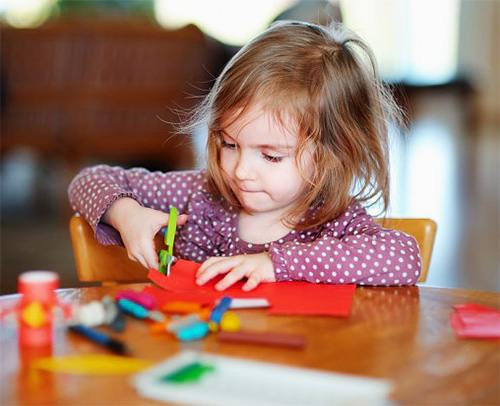
For example, a four-year-old child is quite capable of handling glue and even scissors on his own, while a three-year-old will be happy to help you glue and cut out the selected animals.
Note
The picture of a pet can already be in color - and all that remains is to print it on a color printer, and then cut it out together with the child and glue it onto thick cardboard. However, it can also be black and white - then the animal can be colored, while also repeating the names of the colors in English.
The image of the animal on each of them should be clear and large, so that the baby can easily distinguish who is grazing in the meadow and who is swimming in the pond.
Below we offer black and white and color pictures of pets that are easy to save and print.
Pets in color - who, how, why and why
Before you start cutting out cards, it’s worth repeating pets in English with your baby.
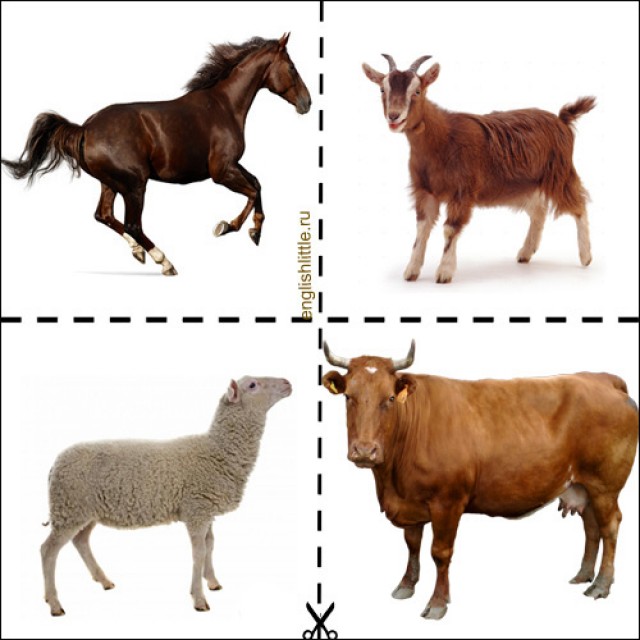
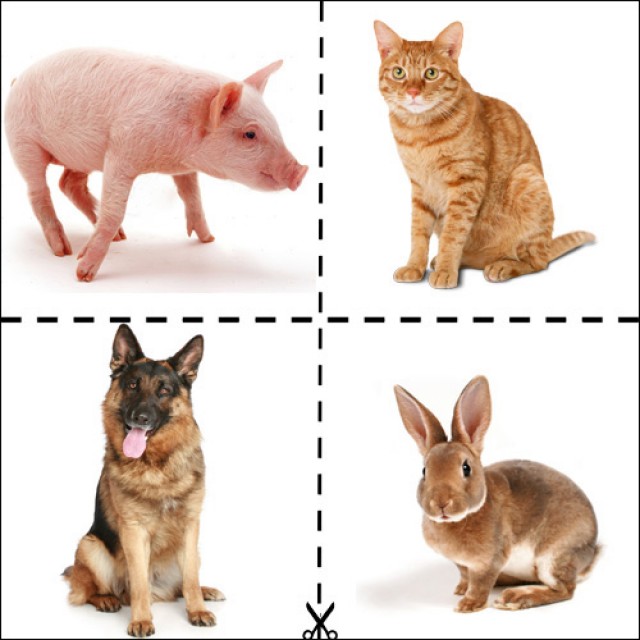

Two-year-olds will be interested in what sounds domestic animals make, what they eat and where they live. Tasks for such kids should be simple. With older children it is already possible to speculate about the benefits such animals bring to humans when they were first domesticated.
Black and white pictures of animals
You can involve a child of any age in making cards. You can accompany the process of cutting out and coloring cards with stories about pets, not forgetting to repeat their names in English.
Various topics can be covered:
- Who was the first person to domesticate and why? R. Kipling's fairy tale “The Cat That Walked By Itself” will be useful in this regard. It perfectly illustrates the consistency with which man domesticated domestic animals.
- Why do people need pets? Here you can tell how each pet helps a person in everyday activities on the farm. Hens lay eggs. Cats catch mice. Sheep give wool.
- What does a cow eat and what does a chicken eat? Great topic in order to repeat the names of some food products in English, for example, Horses like grass. Hens like grain. Cats like milk...
![]()


Games with cards not only develop attentiveness and help the child navigate the world around him, but also enrich his English vocabulary in an accessible form without boring cramming and a series of similar exercises.
Let's act out a scene
Children's works that feature pets are perfect for playing with cards. Already from the age of two, you can use fairy tales (for example, The Musicians of Bremen), English poems about animals.
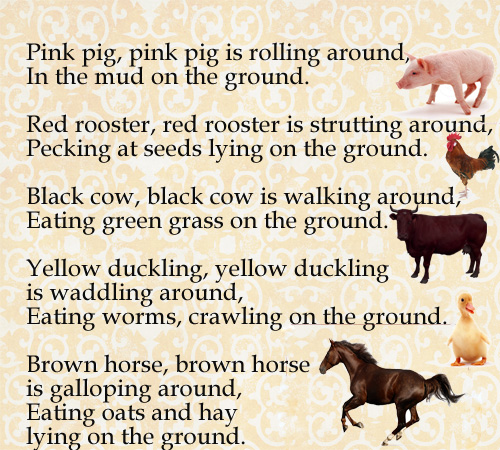
Read or tell a poem or story and, as animal characters appear, ask your child to find a card with a picture of the animal.
Game Who lives in the barn?
Draw a barnyard with your child. Place the animals in their “homes”. Place the pig and cow in a barn (in English barn), send the ducks to splash in the pond (pond), take the horse to the stable (stable), place the rooster and chickens in the chicken coop (coop), and put the dog in the kennel (doghouse).
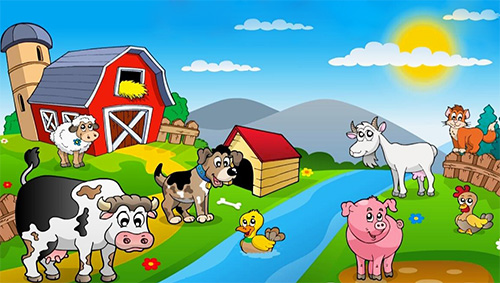
Mix up the cards - for example, put the pig in the kennel, and put the dog in the chicken coop. Ask your child to take on the role of a caring owner who has returned from the village fair and now has to restore order and resettle the naughty animals in their places.
Game Who said moo?
Place the cards on the floor or table (let your child help you). Invite your child to choose one card at a time. At the same time, clearly pronounce the name of the depicted pets in English and imitate their sounds. Offer to repeat. For those who are not sure what sounds each animal makes in English, this funny video of different animals making their own sounds will help.
Pets and their sounds
When the child remembers who “speaks” what, complicate the task. Let the child choose cards, and you deliberately confuse the sounds they make. The child, of course, will not agree that the dog meows and the cat barks or moos. Then invite him to voice this or that animal himself.
An example of such a game can be seen in the video below.
Song-game Old Macdonald's Farm
It is impossible to imagine learning English without learning the names of animals. After familiarizing yourself with a minimum of vocabulary and the simplest grammatical structures, you need to move on to short texts in which the presence of animals as characters is highly desirable. When we teach animals in English for children, the traditional set includes approximately equal numbers of domestic and wild fauna. It is better to start memorizing with one-syllable words, gradually moving to two- and three-syllable names.
Animal names in English
At the very beginning of training, it is acceptable for animals in English to be learned with pronunciation in Russian, that is, with Russian transcription. It is strongly recommended that, in parallel with memorizing words, you learn English transcription signs, without knowledge of which it will be impossible to work with any dictionary.
Domestic animals
Cat - Cat
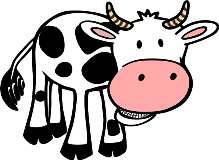 Cow - Cow
Cow - Cow
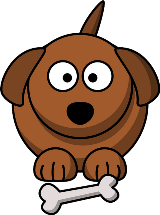 Dog - Dog
Dog - Dog
 Duck - Duck
Duck - Duck
 Donkey - Donkey
Donkey - Donkey
 Goat - Goat
Goat - Goat
 Goose - Goose (goose)
Goose - Goose (goose)
 Hamster - Hamster (hamste)
Hamster - Hamster (hamste)
 Chicken - Hen
Chicken - Hen
 Horse - Horse (hos)
Horse - Horse (hos)
 Mouse - Mouse (mouse)
Mouse - Mouse (mouse)
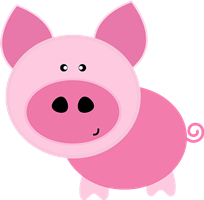 Pig - Pig (pig)
Pig - Pig (pig)
 Rabbit - Rabbit
Rabbit - Rabbit
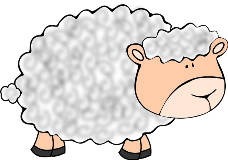 Sheep - Sheep (thorn) [ʃ I:p]
Sheep - Sheep (thorn) [ʃ I:p]
Having gone to the section on animals in English with a translation into Russian, it is very important to explain to the child that the British not only call animals “not our way,” but also hear most of the sounds they make differently from us. For example, an English dog barks "bow-bow" or "woof-woof", the chicken clucks "cluck-cluck", the mouse squeaks "squeak-squeak" and the sheep bleats "baa-baa".
It's helpful to introduce these sounds with suggestions like this:
- The pig on the farm goes “oink-oink”.
- The horse on the field goes “neigh-neigh”.
- The cow on the meadow says “moo-moo”.
Children notice that native speakers hear some animals in a very unique way, and, for example, the mooing of a cow or the meowing of a cat is reproduced approximately equally by our speech apparatus.
It is also useful to compose dialogues with approximately the following content:
- - What does the cat on the roof say?
- It says “miaow”.
Or a little more complicated:
- - Does the duck in the pool say “oink-oink”?
- No, it isn't. The duck says “quack-quack”.
Wild animals
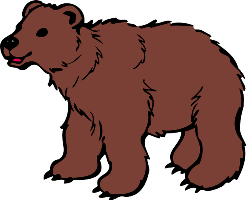 Bear - Bear (bee)
Bear - Bear (bee)
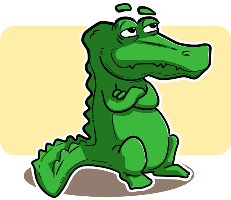 Crocodile - Crocodile (crocodile)
Crocodile - Crocodile (crocodile)
 Deer - Deer
Deer - Deer
 Elephant - Elephant
Elephant - Elephant
![]() Giraffe - Giraffe (giraffe)
Giraffe - Giraffe (giraffe)
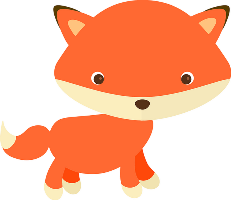 Fox - Fox (fox)
Fox - Fox (fox)
 Koala - Koala (kouale)
Koala - Koala (kouale)
 Leopard - Leopard (laped)
Leopard - Leopard (laped)
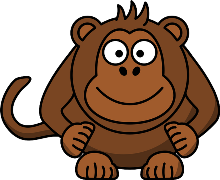 Monkey - Monkey (monkey)
Monkey - Monkey (monkey)
 Ostrich - Ostrich [ɔstritʃ]
Ostrich - Ostrich [ɔstritʃ]
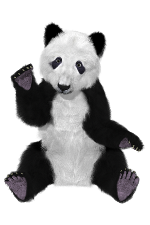 Panda - Panda (panda)
Panda - Panda (panda)
![]() Snake - Snake (snake)
Snake - Snake (snake)
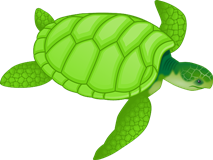 Turtle - Tortoise (totes)
Turtle - Tortoise (totes)
 Keith - Whale
Keith - Whale
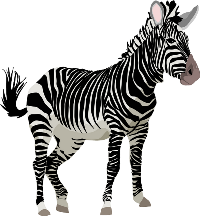 Zebra - Zebra (zebra)
Zebra - Zebra (zebra)
He, she or it?
When learning the names of wild animals, there is no particular need to reproduce sounds, perhaps with the exception of snakes (hiss). It should be noted that in everyday situations and in real life pronouns he And she are not used in relation to animals. In most cases, you need to use a pronoun it, which is used when referring to inanimate objects. For example:
This is a crocodile. It is green long and fierce.
In fairy tales and some stories, animals are personified and “rewarded” with the pronouns he or she. Also in English there is one very interesting feature: when you are told about any animal that has a nickname or name (in fairy tales), it is “introduced” as follows:
John, the Cat
Gray, the Horse
Martin, the Bear.
Smart as a monkey
Just like in the Russian language, animals from the British or Americans are endowed with qualities that are inherent in some people. In some cases, these comparisons coincide with ours, when they say about a person that he has the strength and endurance of a horse. For example:
Dick was strong as a horse and he could easily make fifteen kilometers on foot.
On the other hand, when we teach animals in English to children, they need to be taught that we and native English speakers have differences in mentality, and therefore we perceive many realities of life differently. In the field of the animal world, this is especially pronounced in relation to wolves and monkeys. Yes, in some fairy tales we treat the wolf with disdain, but we will never compare a man with a wolf in the following way:
"He's stupid as a wolf", and English-speaking people do this: "Brian's as stupid as a wolf".
Even more curious is the attitude of the British towards monkeys. If we say that a person is as smart as a monkey, most likely he will take this as an insult, but among native speakers this is literally the highest praise:
“Tracy has finished her school with honors - she’s as clever as a monkey”.
As a rule, such transfers of human characters onto animals can be found in fables in literature. Characters There are usually various animals there. Reading fables in English is one of the ways to replenish vocabulary, there you will find many names of animals, words that describe character and behavior. At the end of each fable there is usually a moral stated. From these final proposals characterizing different life situations, you can take a lot of useful things to enrich your speech.
On the educational site, in addition to short funny stories, interesting stories and fairy tales, English fables are also used to learn English. On our website, a user with any initial level of knowledge will find suitable educational material for himself.
We are all essentially creatures with animal instincts, although we are very different from their class. But they are all not just “neighbors” who live nearby, but creatures without whom we cannot live. Someone gives us food, someone pleases our pride and feels our love and care, and someone, sometimes, strikes fear or makes us admire the creations that nature has created.
Based on this, the entire animal world can be divided into several groups. The names of animals in English will be useful not only when studying this topic, but also in the future, for example, when watching films, TV shows, or visiting zoos. So, let's study everything in groups.
Domestic animals
Over the course of many centuries, many representatives of this world have become our friends. I wonder what pets are called in English? Indeed, despite the fact that they have many similarities with wild ones, they have different “names”.
Cubs - Kids:
Pets:
| dog | dog |
| cat | cat |
| parrot | parrot |
| hamster | hamster |
| guinea pig | guinea pig |
Dog breeds:
boxer, bulldog, collie, cur (mongrel), duchshund (dachshund), dobberman terrier, poodle (poodle), sheep-dog (shepherd), spaniel, st bernard, wolf-hound (wolfhound)
Wild Animals
You can often find the names of wild animals in English in zoos, reading books, newspapers or just watching Animal Planet. To make it easier for you to navigate this topic, we will analyze each type. Some of them herbivorous animals, and some predators (predatory animals). Some are protected by law (protected by law), because they are in danger, on the verge of extinction (endangered pieces), but others don't.
Insects:
Exotic:
Non-exotic:
Birds:
Appearance
All representatives of nature have special distinctive features. Let's look at the elements of appearance. After all, it is very useful to know what not only animals sound like in English, but also their special characteristics.
tail- tail
tail unit- plumage
antlers- branched horns
beak- beak
paws - paws
whiskers- mustache
horn- rhinoceros horn
tusks- tusks
trunk - trunk
main - mane
claws- claws
hooves — hooves
pouch- kangaroo's pouch
wing-wing
Some useful animal expressions
a flock of birds- flock of birds
a school of fish- school of fish
a heard of cows- a herd of cows
a colony of monkey/ants- family (flock) of monkeys, ants
a swarm of flies- swarm of flies
a team of dogs- dog team
All animals in English with transcription, which you will find in the dictionary on our website, will help you not only correctly name each species, but also construct sentences, navigate this topic and create a good topic, expand your vocabulary.
Goat, cow, chicken, sheep, dog with captions in English. Previously we studied. One of the fundamental platforms on which the entire further development process is built foreign language These are the names of animals in English.
Pets appear in most fairy tales and stories, and are used as heroes to create thematic exercises and assignments. Therefore, knowing what they are called is simply necessary.
They are a good way to remember the names of the most common animals; In English, next to each character its name is written. This benefit includes visual analyzers and the baby’s visual memory.
If, while looking at pictures, you clearly and understandably read out loud the names of the characters, auditory memory will also be included in the process of studying them.
To activate motor memory, you can make cards from pictures by printing them and gluing them on cardboard. As we rearrange the cards, we say the name of the character.
This activity will be even more productive if the inscriptions indicating what pets are called in English in the pictures are separated from the image of the animal itself: you can fold the inscription to the wrong side or cut the cards into two parts.
In the first case, you can use a magnetic board or even a sheet of plain paper. We take out a picture with an animal, put it on a sheet of paper and sign its name below. We bend the edge and compare what we wrote with what is written on the card.
In the second, looking at the animal, the baby will have to remember the name and find it among the cards with English inscriptions.
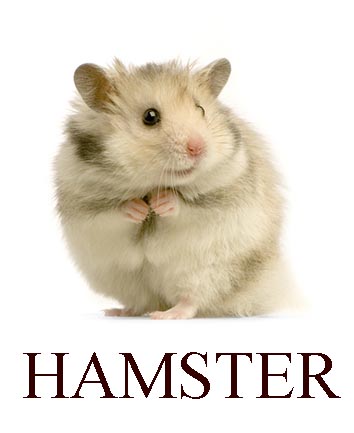

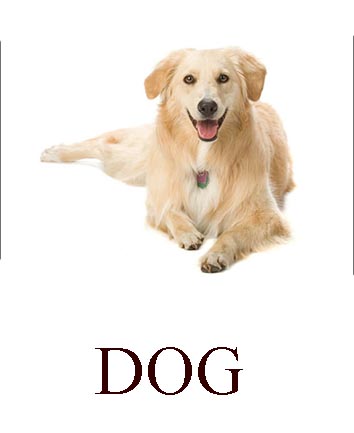
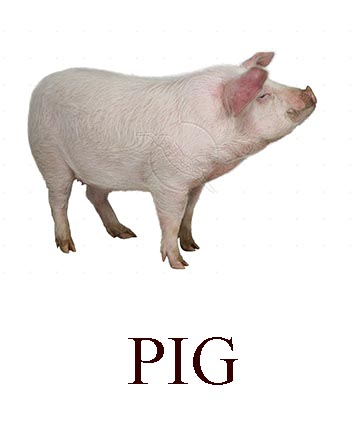
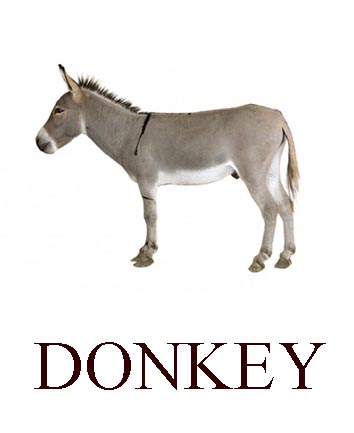

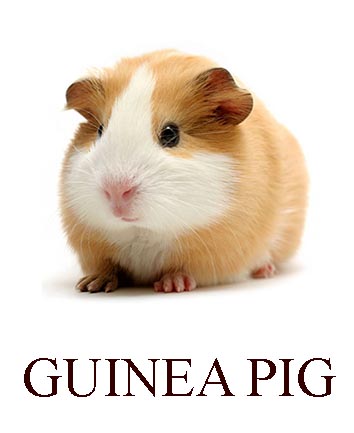
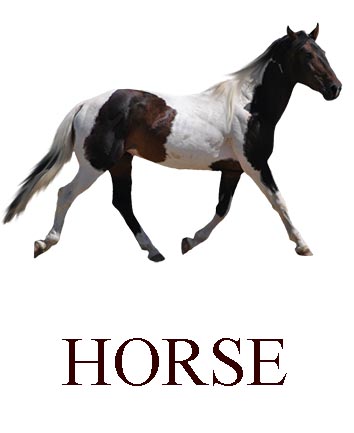


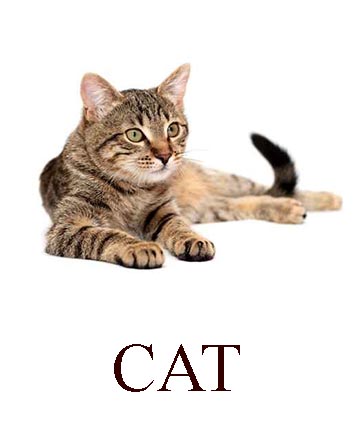
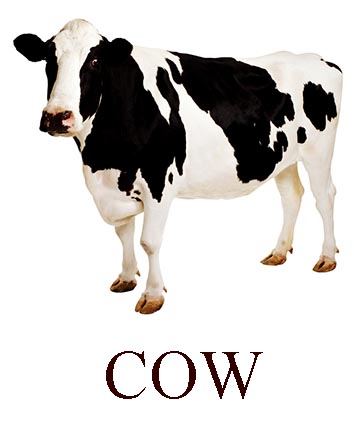
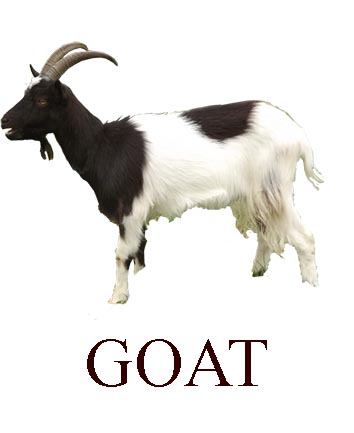

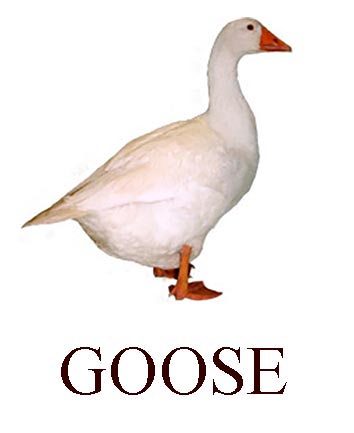
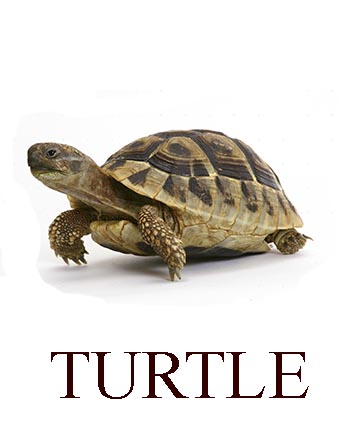
You can use cards to perform various game exercises: for example, play a fair: one player becomes a buyer, the other becomes a farmer-seller. The buyer names in English what animal he wants to buy, and the farmer “sells” him the corresponding card. Then the players change roles.
If there are several children, you can make several sets of cards and arrange a competition: sorting through a stack of cards, each child names the animal that fell to them. The winner is the one who makes no mistakes and pronounces the words quickly without thinking.
The material is considered fully mastered when, having heard the name of an animal in Russian, the child can write it correctly in English, and vice versa. Then you can play with your child by making up. If the child does not yet have writing skills, you can limit yourself to the oral form of answers.



